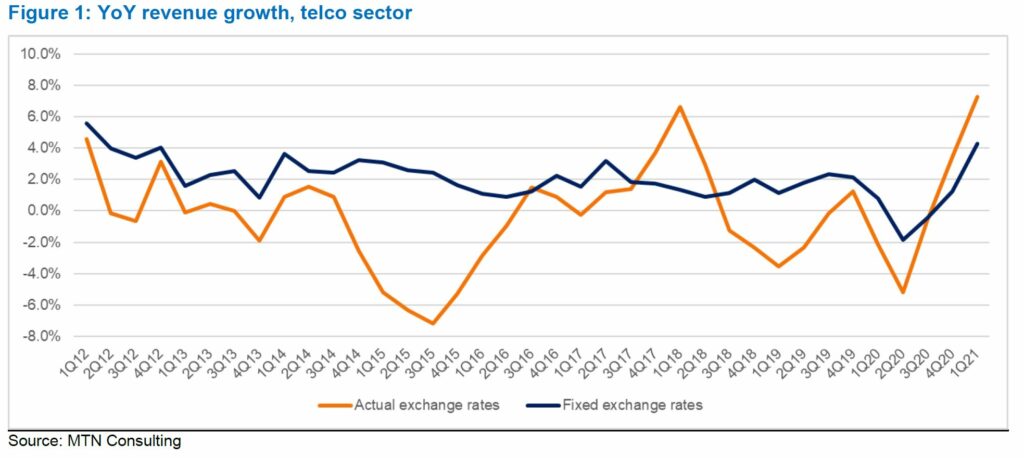By Matt Walker
Revenues for the telecom sector saw a rebound in 1Q21, up 7.3% from 1Q20, to $473.2 billion. This is the fastest growth in at least a decade. Three factors are responsible. First, the base period of 1Q20 was weak due to the initial spread of COVID-19, when travel and regular work routines both came to a standstill. Second, as 5G network penetration has grown, telcos have recorded an impressive uptick in (one-time) device/equipment revenues. Finally, 1Q21 saw a sizable drop in the US dollar’s relative value in several key markets, including China, Europe, Japan, and Australia. Holding exchange rates fixed, the telco industry growth rate in 1Q21 would have been 4.3%.
The momentary revenue upswing in 1Q21 did not cause telcos to go on a sudden spending spree. They have been on the march towards cost reduction via digitation, virtualization, and automation for many years, and nothing has changed. That impacts capital expenditures: capital intensity in the telecom industry declined again in 1Q21. For the four quarters ended March 2021, annualized capex amounted to 16.33% of revenues, from 16.43% in 4Q20. This is the seventh straight sequential decline, and consistent with MTN Consulting’s expectation that capital intensity decline towards the 15.0% range by 2025.
Telcos are beginning to spend more on the cloud, with AWS, Azure and GCP recording well over $1B (combined) in sales to this vertical in 2020 (MTN Consulting estimate). Some portion of this flows into opex, not capex, but opex has also been held in check. Opex excluding depreciation & amortization amounted to 66.1% of revenues for the 1Q21 annualized period, unchanged from 4Q20 but down significantly from its recent peak of 69.7% in 4Q17. Telco profit margins improved throughout 2020, on an EBIT and EBITDA basis; in 1Q21, annualized EBITDA margin stayed flat at 33.9% but EBIT margin climbed to 14.8%, from 14.5% in 4Q20.
Industry headcount fell again in 1Q21, down another 27K to 4.856 million. Just as telcos are trimming capex in order to cut costs, they hope that fewer employees will lower opex, especially when combined with investments in automation and digitization across the business. Spending on employees (aka labor costs), however, are climbing on a per-head basis and as a percentage of opex. That is consistent with our forecast. The average telco employee is changing over time; unionization rates are falling but software development and IT skills are rising, and labor markets are competitive. Labor cost per employee was $59.8K per year in 1Q21, up from $58.1K in the 1Q20 period.
Note: this report is based upon preliminary numbers excerpted from a report to be published later in June (“Telecommunications Network Operators: 1Q21 Market Review”).
- Table Of Contents
- Figures
- Coverage
- Visuals
Table Of Contents
Summary – page 2
Revenue growth rate highest in at least a decade in 1Q21 – 2
Network spending a mixed bag – 5
Outlook for 2021 – 7
Appendix – page 9
Figures
Figure 1: YoY revenue growth, telco sector
Figure 2: Comparison of 5G and 4G subscription uptake in the first years of deployment (billion)
Figure 3: YoY telco revenue growth in 1Q21 – total versus equipment only
Figure 4: Annualized capex & capital intensity since 4Q11
Figure 5: Annualized EBIT and EBITDA margins since 2Q19, telco industry
Coverage
Companies and organizations mentioned in this report include:
Airtel
AIS
Amazon Web Services (AWS)
American Towers
Apple
AT&T
BCE
Cellnex
Charter Communications
China Unicom
Chunghwa
CK Hutch
Deutsche Telekom
Dish Network
Ericsson
Etisalat
Frontier Communications
Globe Telecom
Google Cloud Platform (GCP)
KPN
KT
Microsoft Azure
Millicom
MTS
Orange
PLDT
Proximus
Samsung
Shaw
SK Telecom
StarHub
Telecom Italia
Telefonica
Telenor
Telkom South Africa
True Corp
Turkcell
US FCC
Verizon
Vodafone
Zain
Visuals


